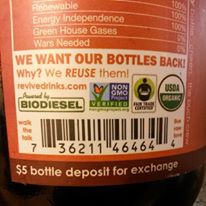 Revive Kombucha breaks the throw-away cycle.
Revive Kombucha breaks the throw-away cycle.
The innovation driving the natural foods industry is comparable to anything you see coming out of Silicon Valley. Organic foods and drinks are taking up more conventional grocery shelf space each year, and our palettes are warming up to everything from chia pudding to unsweetened quinoa milk. Yet with all of the effort companies have put into bringing new, sustainable products to market, few take any revolutionary approaches to reusability.
Sonoma County’s Revive Kombucha is not the only kombucha competing for organic buyers in the cold ready-to-go drinks case, but they are one of the only brands encouraging customers to return their bottles to any store selling their products so that they can be reused.
The “buch” comes in four flavors: the original flavor, or “OG,” begins with a black tea culture; “Red” roots from a culture of hibiscus flower; “Gold” is brewed from coffee; and Revive’s latest flavor, “Solar,” is derived from yerba mate. The brews are raw, organic, non-GMO, fair trade, and gluten-free.
Brewed and batched in Windsor, each flavor comes in a size 16 oz. amber bottle or large 64 oz. The high-quality bottles are worth a deposit on the original cost: $2 for 16 oz. drinks and $5 for 64 oz.
Revive’s bottle exchange program has helped the company divert 180,000 pounds of glass from landfills, according to data collected in Northern California between August 2010 and December 2012. That’s 130,000 bottles.
“It’s like running two different businesses,” says Revive founder Sean J. Lovett of creating the kombucha, which is still brewed in small batches as it was when the company launched in 2010, and running Revive’s bottle exchange program. “It’s challenging.”
Sustainability on this level takes work to pull off efficiently. The used bottles are collected by truck drivers as part of their usual delivery routine: when a drop-off is made, old bottles left by customers are picked up and brought back to rejoin the system. And as new amber bottles don’t need to be made, a great deal of energy is being preserved.
We're not just working to sell a product, there's a greater mission behind what we're trying to do. Sean J. Lovett
The inspiration behind the bottle exchange program came to Lovett while he was in the beginning stages of his business. “I woke up one day designing packaging [and] got a vision of one of our bottles at the time that wasn’t going to be reusable,” Lovett says. “I just thought, no, I don’t want to contribute to that.”
Years later, customers are contributing to Revive’s sustainable system, with a return rate of 71 percent for 16 oz. bottles and 76 percent for 64 oz. bottles.
While the company works for a sustainable ideal, the cost of enacting this system is not inconsiderable. But Lovett points out the benefits, notably customer loyalty in a competitive segment of the market, and being aligned with a larger purpose.
“I think that culturally, it provides a really cool foundation for our business,” he says. “We’re not just working to sell a product, there’s a greater mission behind what we’re trying to do.”
While he admits that it’s a costly program, Lovett says there are plenty of others that can follow suit.
“There are a lot of companies that should be using capital money to innovate their packaging,” he says. “They should be thinking, they have the resources. They should have a perfectly biodegradable plastic bottle by now.”
When faced with the realities of running a hardline sustainable business, Lovett is not squeamish. But ultimately, he chooses change.
“It’s going to take a long time,” Lovett says. “It’s not a practical reality the whole industry is going to change. But we use it, and it’s fine.”
